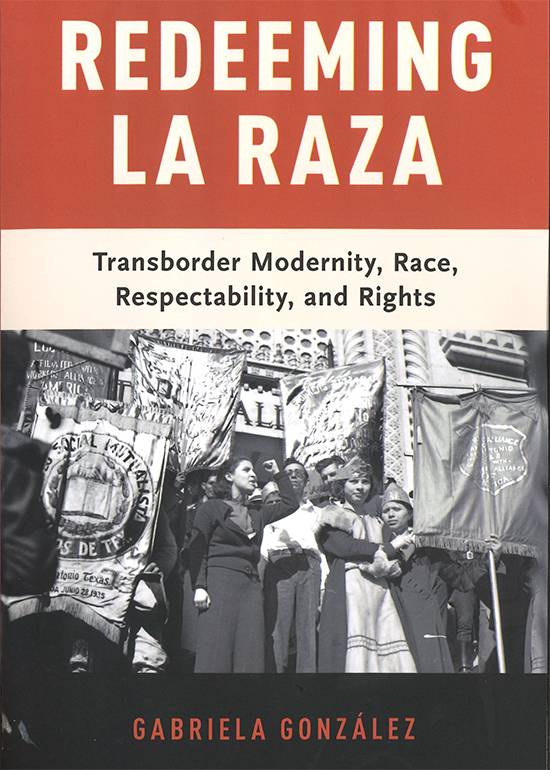Refocusing Texas Politics

Redeeming la Raza: Transborder Modernity, Race, Respectability, and Rights
by Gabriela González
New York: Oxford University Press, 2018.
261 pp. $35.00 paper.
Reviewed by
John Mckiernan-González
On July 14, 2017, JOLT announced its Quinceañera campaign, seeking to harness cultural rituals to transform politics in Texas. Combining precise footwork and cumbia beats at the steps of the Texas Capitol, Viridiana Sanchez and her fellow quinces declared that they too, were on the cusp of adulthood and, collectively, on the cusp of political power. Gabriela González’s new book Redeeming la Raza makes it clear that these young female activists are the most recent variation of women seeking to use culture to transform power in the complicated unequal borderland space we call Texas. The book highlights the challenges and complications facing activists, mostly women, forced to negotiate the intertwining of U.S. and Mexican state authorities and cultures between the Porfiriato and the dawn of the Cold War.
Redeeming la Raza begins with the first organizations seeking to organize artisans, factory workers and displaced peasants in the rail corridor linking Monterrey, Nuevo Leon and San Antonio, Texas. González takes a far closer look than previous historians at the gender and class dimensions of exile newspapers and mutual aid organizations centered around Laredo. Taking advantage of the recently released Idar family papers, Gonzalez draws a direct family line from the first organizers of railroad unions in Northern Mexico (Federico Idar) to feminist undercurrents and backlashes in the AFL, IWW, PLM through the revolutions in Mexico (the Idar family and the Magonistas). This line does not imply agreement, as Gonzalez draws out multiple disagreements among political exiles over the proper attitude of workers toward capital and the nation. Her subsequent discussion of the maternalist politics of Mexican anarchists in the United States highlights how Magonista activists used idealized versions of the family to challenge the role of capital (railroads, farms, rangers and armed mobs) in exploiting and constraining working-class Mexican families. The broad debates across organizers over the role of the Mexican nation regarding the plight of ethnic Mexican workers in the United States complicates Benedict Anderson’s idea that the nation is an imagined community often forged in exile. The only place activists seemed to agree is that women’s entrance into politics followed from their status as guardians of their daughters, sons and husbands. The first few chapters of the book bring out the ways organizers sought to make sense and challenge the industrial transformation of northern Mexico and South Texas.
Many scholars have emphasized a broad decision among organized ethnic Mexican communities in Texas to engage English-speaking political cultures in the United States after the backlash against Mexicans in Texas during the Mexican Revolution. Like Richard Garcia, Mario Garcia, Benjamin Johnson, Leticia Garza-Falcon, Cynthia Orozco, John Moran Gonzalez and Carlos Blanton, Gabriela González emphasizes the hold a faith in respectability and diligence and education had on this generation of Mexican American and Mexican activists. However, by putting women at the center of her analysis of respectability and ethnic politics, Gonzalez brings out the ways even middle-class activists were badly served by this faith in respectability. For example, LULAC auxiliary founder Alice Dickerson Montemayor organized teenagers and little schools, looking for ways to get teenagers – by definition, people without a franchise – involved in politics early. Rather than follow her dismissal by her fellow Lulackers for this decision to organize the unorganizable, González points to the ways Dickerson Montemayor challenged the political distinction between citizens and others embraced by the official culture of LULAC and the broader cultures of the United States. She uses diary entries from Emma Tenayuca to point out the discomfort with decisions—like holding a Communist Party meeting at a WWI veterans memorial being an unnecessary provocation – made by her fellow labor organizers. After reading this book, people should appreciate the broad overlaps in strategies connecting labor organizing with school advocacy, poll tax payments with cultural enrichment before World War II and the GI Bill generation. Redeeming la Raza leaves a vivid portrait of the cross-border organizing done by community-based activists in Texas during the hardening of Jim Crow and the U.S. Mexico border after World War I through the New Deal. In doing so, Gabriela Gonzalez demonstrates how difficult and important it is to redirect culture into politics in borderlands spaces such as Texas and the United States.
John Mckiernan-González is the Director of the Center for the Study of the Southwest, the Jerome and Catherine Supple Professor of Southwestern Studies, and an Associate Professor of History at Texas State University. His first book, Fevered Measures: Public Health and Race at the Texas-Mexico Border, 1848-1942 (Duke, 2012), treats the multi-ethnic making of the U.S. medical border in the Mexico-Texas borderlands.”.
